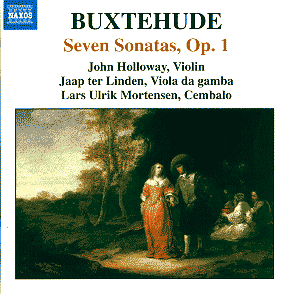Originally
released in 1995 on the Danish Da Capo label this disc marks
the continuation of Naxos’s commitment to Buxtehude following
on from their complete organ music project. It is often said
that any musician who the great J.S. Bach though it worth walking
300 miles to hear must be worthy our attention. For myself I
used to be sceptical of that story but now, having reviewed
a few Buxtehude discs and having heard other works, I feel that
the great J.S. was quite right. It must be remembered however
that it was Buxtehude’s organ improvisations that especially
attracted Bach. Now, if only we could hear those. Nevertheless
Buxtehude did write considerable quantities of chamber music
and it is of high quality and interest.
The
first really significant recording was by Trio Sonnerie directed
by Monica Huggett on the ASV label in 1986. An LP originally
the programme incorporated pieces from both Opp. 1 and 2. This
was good because, as we are reminded in the excellent if rather
analytical booklet essay by Niels Martin Jensen, Buxtehude regarded
the two volumes as a complete unit.
This
new CD gives us an opportunity to hear just the Op. 1 set -
Op. 2 will soon follow - and one can assess the astonishing
variety that the fifty year old composer created. Mr Jensen’s
essay gives us not only an excellent potted biography but also
a quite detailed analysis of each sonata, movement by movement.
I followed these notes assiduously whilst listening and was
glad that I did.
Buxtehude’s
only major publications in his lifetime were of chamber music.
These took place between 1694 and 1696. The seven books of sonatas
show a fusion of influences from South Europe to the North via
Paris. The Italian influence brings with it demanding idiomatic
writing for violin. Dramatic effects derived ‘style rappresentative’
also appear imparting a sense of the music telling a story.
The English contributed the virtuoso viol tradition and the
fantasy and fantasy-suite forms. The German and Austrian traditions
contributed fugal and contrapuntal movements in which the composer
could show off his polyphonic skills.
The
sonatas are made up of contrasting sections of varying number
and length. Some are dances and some are variations with recitative-like
transitional passages or simple showy bursts of passagework
in a style now commonly known as ‘stylus phantasticus’. The
gamba plays a true obbligato part, completely independent of
the harpsichord’s basso continuo. In fast movements the texture
is in two real parts with, some of the time, the bass playing
a simplified version of the solo part. Almost every sonata has
an ostinato bass movement whether in the form of chaconne-like
repetitions or of harmonic passages. The Op. 1 no. 2 in G major
is typical. It starts with a sonorous introduction marked lento
but only three bars long. This leads directly into a lively
fugal vivace. There is then a chromatic adagio which
goes into a compound time allegro in the relative minor,
based on a flourish of arpeggios in the violin. The ensuing
largo, which is full of delicious suspensions,
brings us back to G major. An arioso with variations
explores the possibilities of an eight-bar repeated bass line
which is where the sonata ends.
Although
it is the first sonata that I have briefly analysed, I need
to add that despite the fact that each sonata is made up of
these short sectional ‘sound-bites’ each is also utterly different
and distinctly original. Buxtehude had such a lot to say musically,
that he never repeats himself or his formulae.
I
am in full agreement with the ‘American Record Guide’ which
is quoted on the back of the CD case: “It is difficult to imagine
a better recording of these pieces” and I would add emphatically,
“and, of course, a better performance”.
The
fertile world of these seven sonatas is not esoteric or challenging
but joyous and clever and life-enhancing, so that the more you
listen the more you hear.
Gary Higginson

![]() John Holloway, violin; Jaap ter Linden, viola da gamba; Lars Ulrik Mortensen,
cembalo
John Holloway, violin; Jaap ter Linden, viola da gamba; Lars Ulrik Mortensen,
cembalo![]() NAXOS
8.557248 [57.32]
NAXOS
8.557248 [57.32]





